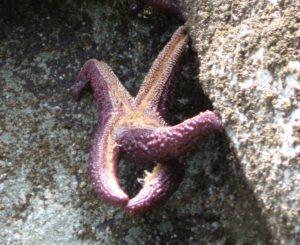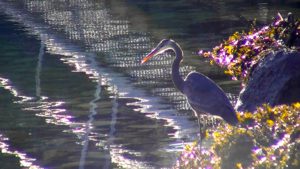The intertidal zone is the part of the beach covered by water at high tide and exposed at low tide. It is regularly exposed to the air, wind, sun, rain, and sea water as the tide moves in and out, so animals and plants that live here have to adapt to an ever-changing environment.
Despite this challenge, this part of our coastline is full of life. It provides a home to many different species, acts as a nursery for numerous subtidal (deeper water) species and is an important indicator of the overall health of the marine environment.
Here are just a few examples of the animals and plants who call the intertidal zone home:
 Sea stars, with their tough, leathery surfaces that prevent them from drying out when exposed to air at low tide, are well suited to the constantly changing environment here.
Sea stars, with their tough, leathery surfaces that prevent them from drying out when exposed to air at low tide, are well suited to the constantly changing environment here.
Crabs cope with the changing tides by moving up and down with them.
The black oystercatcher, despite its name, usually dines on limpets and mussels which it pries off the rocks with its bill.
Eelgrass grows up to 4 feet long, in large meadow-like beds that provide habitat for fish and invertebrates. Eelgrass roots help stabilize mud or sand bottoms..
 Eelgrass meadows are essential for a number of birds, including the great blue heron. Herons wade in the shallows and catch small fish and crabs by stabbing them with their narrow bills.
Eelgrass meadows are essential for a number of birds, including the great blue heron. Herons wade in the shallows and catch small fish and crabs by stabbing them with their narrow bills.
Want to learn more about what lives in the intertidal zone? Download this guide to see what you will find, check out our Steward of the Strait guide on how to explore our shores or do you own quadrat study.
